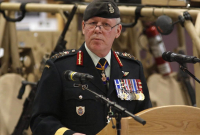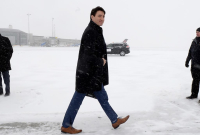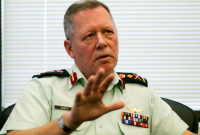Support strong Canadian climate journalism for 2025
Canada's top military officer admits there has been slower progress than expected to get more women into the Canadian Forces.
New figures show there has been only a small increase in the number of women in the military over the last two years, but General Jonathan Vance says he remains committed to his goal of having women represent one-quarter of all military personnel by 2026.
"I'm pushing for 25 per cent women," Vance told The Canadian Press. "I would rather be criticized for trying and failing and making significant incremental growth than for not trying at all."
The Canadian Forces has struggled for years to increase the number of women, visible minorities and Indigenous People in the ranks, prompting some in the past to question whether its targets should be revised downward.
Vance instead publicly asserted in February 2016, shortly after taking command of the Forces, that he wanted one in four service members to be women by 2026. At that time, barely 15 per cent of service members were women.
The latest figures provided by the Department of National Defence show at the beginning of January that had grown to 15.7 per cent.
"It's not going up as fast as I thought it might," Vance said.
But, he added, "we know for sure that there's a healthier workplace with a better gender balance. We know that. So I refuse to abandon the percentage goal."
The 25 per cent target was part of a push to make the Forces more reflective of Canadian society. It was given added importance given concurrent efforts to eradicate sexual misconduct in the military, which had been flagged only the year before as a significant problem in the ranks.
The Trudeau government has also made growing female representation in United Nations peacekeeping a foreign-policy priority.
The military has had noticeably more success with regards to representation of visible minorities, which grew to 8.6 per cent from 7.4 per cent in January 2017. The percentage of Indigenous People remained largely unchanged at 2.8 per cent.
Numerous measures and initiatives have been rolled out over the past three years to increase the number of women in uniform, including targeted recruiting campaigns, improvements to family support and the focus on eliminating sexual misconduct.
And there have been positive signs, Vance said, including a growing number of women studying to become officers at the Royal Military College of Canada and more women taking over senior positions in the Forces.
"Right now retention of women numbers are better than men on a per capita basis," he added. "So retention of women is improving. That's a good thing."
Vance said one thing he will not do is lower the standards that people must meet to join the Forces. Instead, he said military officials must think creatively and find new ways to meet the goal.
"The numbers are going up slowly, and maybe that's just how it's going to be," he said. "It may not be a per cent a year. It may be 0.7 per cent a year. We're going to try. But I believe you can get to 25 per cent of women in the Armed Forces."





Comments